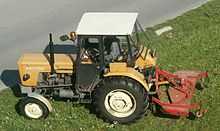Three-point hitch

The three-point hitch (British English: three-point linkage) most often refers to the way ploughs and other implements are attached to an agricultural tractor. The three points resemble either a triangle, or the letter A. Three-point attachment is the simplest and the only statically determinate way of joining two bodies in engineering.
A three-point hitch attaches the implement to the tractor so that the orientation of the implement is fixed with respect to the tractor and the arm position of the hitch. The tractor carries some or all of the weight of the implement. The other main mechanism for attaching a load is through a drawbar, a single point, pivoting attachment where the implement or trailer is not in a fixed position with respect to the tractor.
Harry Ferguson's invention was that where an implement such as a plough exerts a drag force, the linkage may use this to increase the downward force on the rear wheels, and thus the traction available.
The hitch's utility and simplicity has made it an industry standard.
Components

The tractor and linkage are painted gold. The grey bars are a separate implement (a towing ball hitch) attached to the linkage.
The three-point hitch is made up of several components working together. These include the tractor's hydraulic system, attaching points, the lifting arms, and stabilizers.
Three-point hitches are composed of three movable arms. The two lower arms—the hitch lifting arms—are controlled by the hydraulic system, and provide lifting, lowering, and even tilting to the arms. The upper center arm—called the top link—is movable, but is usually not powered by the tractor's hydraulic system. Each arm has an attachment device to connect implements to the hitch.
Each hitch has attachment holes for attaching implements, and the implement has posts that fit through the holes. The implement is secured by placing a pin on the ends of the posts.
The hitch lifting arms are powered by the tractor's own hydraulic system. The hydraulic system is controlled by the operator, and usually a variety of settings are available. A draft control mechanism is often present in modern three-point hitch systems. The draft of the implement, the amount of force it is taking to pull the implement, is sensed on the lower arms and the hydraulic system automatically raises the arms slightly when the draft increases and lowers the arms when the draft decreases.
The primary benefit of the three-point hitch system is to transfer the weight and stress of an implement to the rear wheels of a tractor.
Size categories

There are five different hitch sizes, called categories. The higher category hitches have sturdier lift arms and larger connector pins.[ 1]
| Category | Tractor HP | Top Link Pin Diameter | Lift Arm Pin Diameter |
|---|---|---|---|
| 0 | Up to 20 | 5⁄8 in | 5⁄8 in |
| 1 | 20 to 45 | 3⁄4 in | 7⁄8 in |
| 2 | 40 to 100 | 1 in | 1⅛ in |
| 3 | 80 to 225 | 1¼ in | 1 7⁄16 in |
| 4 | 180 to 400 and up | 1 3⁄4 in | 2 in |
History
Harry Ferguson patented the three-point "linkage" for agricultural tractors in Britain in 1926. His credit does not lie in invention of the device, but in realisation of the importance of rigid attachment of the plough to the tractor. The particular geometry of the linkage that attached the plough to the tractor enabled forces generated by the plough to be applied to the rear wheels of the tractor. This enabled Ferguson's tractor to be much lighter and more manoeuvrable than earlier models of farm tractor. As a result his tractor could operate on soft ground and caused less damage to the soil in comparison with other tractors of the time. In addition, the three-point hitch would prevent the tractor from flipping backwards on the drive wheels if the implement being dragged were to hit a rock or other immovable obstruction. He is also attributed with several innovations to this device (e.g. hydraulic lift) which made this system workable, effective, and desirable to the point of using it on mass marketed tractors (e.g. the Ford-Ferguson 9N). The hydraulically operated and controlled three-point hitch utilized the draft of the mounted tool to moderate the depth of the tool and therefore the load on the tractor.
Before the 1940s, each manufacturer used their own systems for hitching, or attaching their implements to their tractors. Commonplace was the two-point hitch system which could not effectively be used for lifting many implements. At this time, farmers would have to purchase the same brand implements as their tractor to be able to correctly hook up the implement. If a farmer needed to use a different brand implement with the tractor an adaptation kit—which were typically clumsy, ill-fitting, or unsafe—had to be installed.
In the 1960s, tractor and implement manufacturers eventually agreed on the three-point hitch as the one standard system to hitch implements to tractors. As patents on technology expired, the manufacturers were able to refine the system and create useful modifications. Now, nearly all manufacturers have adopted some standardised[ 1] form of the modern three-point hitch system; many companies also offer safe adaptation kits for converting the non-standard hitch systems to the three-point hitch system.
See also
- Overrunning clutch
- Power take-off
Notes
- ↑ "ISO 730-1:1994. Agricultural wheeled tractors – Rear-mounted three-point linkage – Part 1: Categories 1, 2, 3 and 4", ISO
- ↑ "Three-Point Hitch", TractorData.com, retrieved 3 November 2013
External links
| Wikimedia Commons has media related to Three-point hitches. |